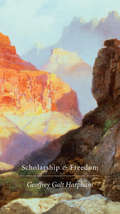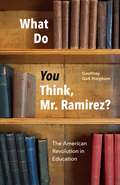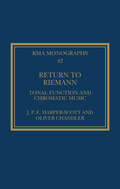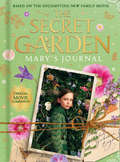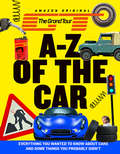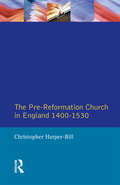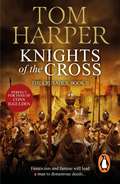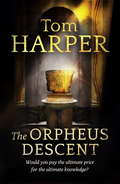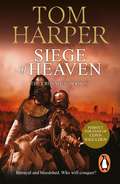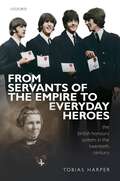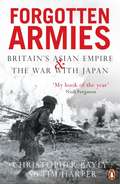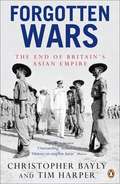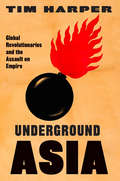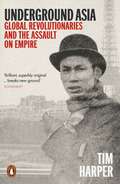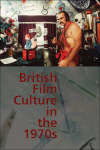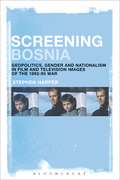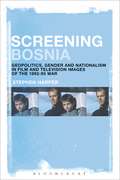- Table View
- List View
Scholarship and Freedom
by Geoffrey Galt HarphamA powerful and original argument that the practice of scholarship is grounded in the concept of radical freedom, beginning with the freedoms of inquiry, thought, and expression. Why are scholars and scholarship invariably distrusted and attacked by authoritarian regimes? Geoffrey Galt Harpham argues that at its core, scholarship is informed by an emancipatory agenda based on a permanent openness to the new, an unlimited responsiveness to evidence, and a commitment to conversion. At the same time, however, scholarship involves its own forms of authority. As a worldly practice, it is a struggle for dominance without end as scholars try to disprove the claims of others, establish new versions of the truth, and seek disciples. Scholarship and Freedom threads its general arguments through examinations of the careers of three scholars: W. E. B. Du Bois, who serves as an example of scholarly character formation; South African Bernard Lategan, whose New Testament studies became entangled on both sides of his country’s battles over apartheid; and Linda Nochlin, whose essay “Why Have There Been No Great Women Artists?” virtually created the field of feminist art history.
What Do You Think, Mr. Ramirez?: The American Revolution in Education
by Geoffrey Galt HarphamGeoffrey Galt Harpham’s book takes its title from a telling anecdote. A few years ago Harpham met a Cuban immigrant on a college campus, who told of arriving, penniless and undocumented, in the 1960s and eventually earning a GED and making his way to a community college. In a literature course one day, the professor asked him, “Mr. Ramirez, what do you think?” The question, said Ramirez, changed his life because “it was the first time anyone had asked me that.” Realizing that his opinion had value set him on a course that led to his becoming a distinguished professor. That, says Harpham, was the midcentury promise of American education, the deep current of commitment and aspiration that undergirded the educational system that was built in the postwar years, and is under extended assault today. The United States was founded, he argues, on the idea that interpreting its foundational documents was the highest calling of opinion, and for a brief moment at midcentury, the country turned to English teachers as the people best positioned to train students to thrive as interpreters—which is to say as citizens of a democracy. Tracing the roots of that belief in the humanities through American history, Harpham builds a strong case that, even in very different contemporary circumstances, the emphasis on social and cultural knowledge that animated the midcentury university is a resource that we can, and should, draw on today.
What Do You Think, Mr. Ramirez?: The American Revolution in Education
by Geoffrey Galt HarphamGeoffrey Galt Harpham’s book takes its title from a telling anecdote. A few years ago Harpham met a Cuban immigrant on a college campus, who told of arriving, penniless and undocumented, in the 1960s and eventually earning a GED and making his way to a community college. In a literature course one day, the professor asked him, “Mr. Ramirez, what do you think?” The question, said Ramirez, changed his life because “it was the first time anyone had asked me that.” Realizing that his opinion had value set him on a course that led to his becoming a distinguished professor. That, says Harpham, was the midcentury promise of American education, the deep current of commitment and aspiration that undergirded the educational system that was built in the postwar years, and is under extended assault today. The United States was founded, he argues, on the idea that interpreting its foundational documents was the highest calling of opinion, and for a brief moment at midcentury, the country turned to English teachers as the people best positioned to train students to thrive as interpreters—which is to say as citizens of a democracy. Tracing the roots of that belief in the humanities through American history, Harpham builds a strong case that, even in very different contemporary circumstances, the emphasis on social and cultural knowledge that animated the midcentury university is a resource that we can, and should, draw on today.
What Do You Think, Mr. Ramirez?: The American Revolution in Education
by Geoffrey Galt HarphamGeoffrey Galt Harpham’s book takes its title from a telling anecdote. A few years ago Harpham met a Cuban immigrant on a college campus, who told of arriving, penniless and undocumented, in the 1960s and eventually earning a GED and making his way to a community college. In a literature course one day, the professor asked him, “Mr. Ramirez, what do you think?” The question, said Ramirez, changed his life because “it was the first time anyone had asked me that.” Realizing that his opinion had value set him on a course that led to his becoming a distinguished professor. That, says Harpham, was the midcentury promise of American education, the deep current of commitment and aspiration that undergirded the educational system that was built in the postwar years, and is under extended assault today. The United States was founded, he argues, on the idea that interpreting its foundational documents was the highest calling of opinion, and for a brief moment at midcentury, the country turned to English teachers as the people best positioned to train students to thrive as interpreters—which is to say as citizens of a democracy. Tracing the roots of that belief in the humanities through American history, Harpham builds a strong case that, even in very different contemporary circumstances, the emphasis on social and cultural knowledge that animated the midcentury university is a resource that we can, and should, draw on today.
What Do You Think, Mr. Ramirez?: The American Revolution in Education
by Geoffrey Galt HarphamGeoffrey Galt Harpham’s book takes its title from a telling anecdote. A few years ago Harpham met a Cuban immigrant on a college campus, who told of arriving, penniless and undocumented, in the 1960s and eventually earning a GED and making his way to a community college. In a literature course one day, the professor asked him, “Mr. Ramirez, what do you think?” The question, said Ramirez, changed his life because “it was the first time anyone had asked me that.” Realizing that his opinion had value set him on a course that led to his becoming a distinguished professor. That, says Harpham, was the midcentury promise of American education, the deep current of commitment and aspiration that undergirded the educational system that was built in the postwar years, and is under extended assault today. The United States was founded, he argues, on the idea that interpreting its foundational documents was the highest calling of opinion, and for a brief moment at midcentury, the country turned to English teachers as the people best positioned to train students to thrive as interpreters—which is to say as citizens of a democracy. Tracing the roots of that belief in the humanities through American history, Harpham builds a strong case that, even in very different contemporary circumstances, the emphasis on social and cultural knowledge that animated the midcentury university is a resource that we can, and should, draw on today.
What Do You Think, Mr. Ramirez?: The American Revolution in Education
by Geoffrey Galt HarphamGeoffrey Galt Harpham’s book takes its title from a telling anecdote. A few years ago Harpham met a Cuban immigrant on a college campus, who told of arriving, penniless and undocumented, in the 1960s and eventually earning a GED and making his way to a community college. In a literature course one day, the professor asked him, “Mr. Ramirez, what do you think?” The question, said Ramirez, changed his life because “it was the first time anyone had asked me that.” Realizing that his opinion had value set him on a course that led to his becoming a distinguished professor. That, says Harpham, was the midcentury promise of American education, the deep current of commitment and aspiration that undergirded the educational system that was built in the postwar years, and is under extended assault today. The United States was founded, he argues, on the idea that interpreting its foundational documents was the highest calling of opinion, and for a brief moment at midcentury, the country turned to English teachers as the people best positioned to train students to thrive as interpreters—which is to say as citizens of a democracy. Tracing the roots of that belief in the humanities through American history, Harpham builds a strong case that, even in very different contemporary circumstances, the emphasis on social and cultural knowledge that animated the midcentury university is a resource that we can, and should, draw on today.
What Do You Think, Mr. Ramirez?: The American Revolution in Education
by Geoffrey Galt HarphamGeoffrey Galt Harpham’s book takes its title from a telling anecdote. A few years ago Harpham met a Cuban immigrant on a college campus, who told of arriving, penniless and undocumented, in the 1960s and eventually earning a GED and making his way to a community college. In a literature course one day, the professor asked him, “Mr. Ramirez, what do you think?” The question, said Ramirez, changed his life because “it was the first time anyone had asked me that.” Realizing that his opinion had value set him on a course that led to his becoming a distinguished professor. That, says Harpham, was the midcentury promise of American education, the deep current of commitment and aspiration that undergirded the educational system that was built in the postwar years, and is under extended assault today. The United States was founded, he argues, on the idea that interpreting its foundational documents was the highest calling of opinion, and for a brief moment at midcentury, the country turned to English teachers as the people best positioned to train students to thrive as interpreters—which is to say as citizens of a democracy. Tracing the roots of that belief in the humanities through American history, Harpham builds a strong case that, even in very different contemporary circumstances, the emphasis on social and cultural knowledge that animated the midcentury university is a resource that we can, and should, draw on today.
Return to Riemann: Tonal Function and Chromatic Music (ISSN)
by J. P. Harper-Scott Oliver ChandlerThis book is a music-theoretical and critical-theoretical study of late tonal music, and, in particular, of the music of Wagner’s Götterdämmerung.First, in terms of music theory, it proposes a new theory of tonal function that returns to the theories of Hugo Riemann to rediscover a development of his thought that has been covered over by the recent project of neo-Riemannian theory. Second, in terms of its philosophical approach, it reawakens the critical-theoretical examination of the relation between music and the late capitalist society that is sedimented in the musical materials themselves, and which the music, in turn, subjects to aesthetically embodied critique. The music, the theory, and the listeners and critics who respond to them are all radically reimagined.This book will be of interest to professional music theorists, undergraduates, and technically inclined musicians and listeners, that is, anyone who is fascinated by the chromatic magic of late-nineteenth-century music.
Return to Riemann: Tonal Function and Chromatic Music (ISSN)
by J. P. Harper-Scott Oliver ChandlerThis book is a music-theoretical and critical-theoretical study of late tonal music, and, in particular, of the music of Wagner’s Götterdämmerung.First, in terms of music theory, it proposes a new theory of tonal function that returns to the theories of Hugo Riemann to rediscover a development of his thought that has been covered over by the recent project of neo-Riemannian theory. Second, in terms of its philosophical approach, it reawakens the critical-theoretical examination of the relation between music and the late capitalist society that is sedimented in the musical materials themselves, and which the music, in turn, subjects to aesthetically embodied critique. The music, the theory, and the listeners and critics who respond to them are all radically reimagined.This book will be of interest to professional music theorists, undergraduates, and technically inclined musicians and listeners, that is, anyone who is fascinated by the chromatic magic of late-nineteenth-century music.
The Secret Garden: Mary’s Journal
by HarperCollinsChildren’sBooksA beautifully illustrated journal of ten-year-old Mary Lennox based on the enchanting new family movie, The Secret Garden, launching globally in Spring 2020. The perfect gift for all fans of The Secret Garden!
The Grand Tour A-Z of the Car: Everything You Wanted To Know About Cars And Some Things You Probably Didn't
by HarperCollinsDid you know there are over 47,000 facts in the world?* And the good news is, many of them are in this book. That’s right, The Grand Tour A-Z of the Car is the only reference guide you need for cars, driving and all related matters, especially if you’re not too fussed about those facts being accurate.
The Pre-Reformation Church in England 1400-1530
by Christopher Harper-BillOffers a concise synthesis of the valuable research accomplished in recent years which has transformed our view of religious belief and practice in pre-Reformation England. The author argues that the church was neither in a state of crisis, nor were its members clamouring for change, let alone `reformation' during the early years of Henry VIII's reign.
The Pre-Reformation Church in England 1400-1530
by Christopher Harper-BillOffers a concise synthesis of the valuable research accomplished in recent years which has transformed our view of religious belief and practice in pre-Reformation England. The author argues that the church was neither in a state of crisis, nor were its members clamouring for change, let alone `reformation' during the early years of Henry VIII's reign.
Knights Of The Cross: the extraordinary story of the First Crusade - gripping from the first page
by Tom Harper1098. The armies of the First Crusade race across Asia minor, routing the Turks and reclaiming the land for Christendom. But on the Syrian border, their advance is halted before the impregnable walls of Antioch.As winter draws on, they are forced to suffer a fruitless, interminable siege, gnawed by famine and tormented by the Turkish defenders. The entire crusade is on the verge of collapse. His lord, the ruthlessly ambitious Bohemond charges Demetrios Askiates to find the killer. But as Demetrios investigates, the trail seems to lead ever deeper into the vipers' nest of jealousy, betrayal and fanaticism which lies at the heart of the crusade.
The Orpheus Descent: A Novel
by Tom HarperI have never written down the answers to the deepest mysteries, nor will I ever... The philosopher Plato wrote these words more than two thousand years ago, following a perilous voyage to Italy -- an experience about which he never spoke again, but from which he emerged the greatest thinker in all of human history.Today, twelve golden tablets sit in museums around the world, each created by unknown hands and buried in ancient times, and each providing the dead with the route to the afterlife. Archaeologist Lily Barnes, working on a dig in southern Italy, has just found another. But this tablet names the location to the mouth of hell itself.And then Lily vanishes. Has she walked out on her job, her marriage, and her life -- or has something more sinister happened? Her husband, Jonah, is desperate to find her. But no one can help him: not the police, and not the secretive foundation that sponsored her dig. All Jonah has is belief, and a determination to do whatever it takes to get Lily back.But like Plato before him, Jonah will discover the journey ahead is mysterious and dark and fraught with danger. And not everyone who travels to the hidden place where Lily has gone can return.
Siege of Heaven: (The Crusade Trilogy: III): a powerful, fast-paced and exciting adventure steeped in the atmosphere of the First Crusade
by Tom HarperAugust, 1098. After countless battles and sieges, the surviving soldiers of the first crusade are at last within reach of their ultimate goal: Jerusalem. But rivalries fester and new enemies are massing against them in the Holy Land.Demetrios Askiates, the Emperor's spy, has had enough of the crusade's violence and hypocrisy. He longs to return home. But when a routine diplomatic mission leads to a deadly ambush, he realises he has been snared in the vast power struggles which underlie the crusade. The only way out now leads through the Holy City.From the plague-bound city of Antioch to the heart of Muslim Egypt, Demetrios must accompany the army of warlords and fanatics to the very gates of Jerusalem where the crusade climaxes in an apocalypse of pillage, bloodshed and slaughter.
From Servants of the Empire to Everyday Heroes: The British Honours System in the Twentieth Century
by Tobias HarperIn the twentieth century, the British Crown appointed around a hundred thousand people - military and civilian - in Britain and the British Empire to honours and titles. For outsiders, and sometimes recipients too, these jumbles of letters are tantalizingly confusing: OM, MBE, GCVO, CH, KB, or CBE. Throughout the century, this system expanded to include different kinds of people, while also shrinking in its imperial scope with the declining empire. Through these dual processes, this profoundly hierarchical system underwent a seemingly counter-intuitive change: it democratized. Why and how did the British government change this system? And how did its various publics respond to it? This study addresses these questions directly by looking at the history of the honours system in the wider context of the major historical changes in Britain and the British Empire in the twentieth century. In particular, it looks at the evolution of this hierarchical, deferential system amidst democratization and decolonization. It focuses on the system's largest-and most important-components: the Order of the British Empire, the Knight Bachelor, and the lower ranks of other Orders. By creatively analysing the politics and administration of the system alongside popular responses to it in diaries, letters, newspapers, and memoirs, Tobias Harper shows the many different meanings that honours took on for the establishment, dissidents, and recipients. He also shows the ways in which the system succeeded and failed to order and bring together divided societies.
From Servants of the Empire to Everyday Heroes: The British Honours System in the Twentieth Century
by Tobias HarperIn the twentieth century, the British Crown appointed around a hundred thousand people - military and civilian - in Britain and the British Empire to honours and titles. For outsiders, and sometimes recipients too, these jumbles of letters are tantalizingly confusing: OM, MBE, GCVO, CH, KB, or CBE. Throughout the century, this system expanded to include different kinds of people, while also shrinking in its imperial scope with the declining empire. Through these dual processes, this profoundly hierarchical system underwent a seemingly counter-intuitive change: it democratized. Why and how did the British government change this system? And how did its various publics respond to it? This study addresses these questions directly by looking at the history of the honours system in the wider context of the major historical changes in Britain and the British Empire in the twentieth century. In particular, it looks at the evolution of this hierarchical, deferential system amidst democratization and decolonization. It focuses on the system's largest-and most important-components: the Order of the British Empire, the Knight Bachelor, and the lower ranks of other Orders. By creatively analysing the politics and administration of the system alongside popular responses to it in diaries, letters, newspapers, and memoirs, Tobias Harper shows the many different meanings that honours took on for the establishment, dissidents, and recipients. He also shows the ways in which the system succeeded and failed to order and bring together divided societies.
Forgotten Armies: Britain's Asian Empire and the War with Japan
by Tim Harper Christopher BaylyThe vast crescent of British-ruled territories from India down to Singapore appeared in the early stages of the Second World War a massive asset in the war with Germany, providing huge quantities of soldiers and raw materials and key part of an impregnable global network denied to the Nazis. Within a few weeks in 1941-2 a Japanese invasion had destroyed all this, almost effortlessly taking the 'impregnable fortress' of Singapore with its 80,000 strong garrison, and sweeping through South and Southeast Asia to the frontier of India itself. This revolutionary, absolutely gripping book brings to life the entire experience of South and Southeast Asia in this extraordinary period, telling the story from an Indian, Burmese, Chinese or Malay perspective as much as from that of the British or Japanese. Effectively it is the story of the birth of modern South and Southeast Asia and the hopes and fears of the dozens of 'forgotten armies' marching through the jungle battlefields, so many dying for causes swept away by the reality that emerged in 1945. Even as the British successfully fought back in the bloodiest battles in South and Southeast Asia's history, there was no going back to colonial rule.
Forgotten Wars: The End of Britain's Asian Empire
by Tim Harper Christopher BaylyThis extraordinary book is a vivid, highly original account of the creation of a new Asia after the Second World War - an unstoppable wave of nationalism that swept the British Empire aside. It tells the definitive story of how India, Pakistan, Burma and Malaysia came into existence and how British interference in Vietnam and Indonesia fatally shaped those countries' futures.
Underground Asia: Global Revolutionaries And The Assault On Empire
by Tim HarperA major historian tells the dramatic and untold story of the shadowy networks of revolutionaries across Asia who laid the foundations in the early twentieth century for the end of European imperialism on their continent.This is the epic tale of how modern Asia emerged out of conflict between imperial powers and a global network of revolutionaries in the turbulent early decades of the twentieth century.In 1900, European empires had not yet reached their territorial zenith. But a new generation of Asian radicals had already planted the seeds of their destruction. They gained new energy and recruits after the First World War and especially the Bolshevik Revolution, which sparked utopian visions of a free and communist world order led by the peoples of Asia. Aided by the new technologies of cheap printing presses and international travel, they built clandestine webs of resistance from imperial capitals to the front lines of insurgency that stretched from Calcutta and Bombay to Batavia, Hanoi, and Shanghai. Tim Harper takes us into the heart of this shadowy world by following the interconnected lives of the most remarkable of these Marxists, anarchists, and nationalists, including the Bengali radical M. N. Roy, the iconic Vietnamese leader Ho Chi Minh, and the enigmatic Indonesian communist Tan Malaka. He recreates the extraordinary milieu of stowaways, false identities, secret codes, cheap firearms, and conspiracies in which they worked. He shows how they fought with subterfuge, violence, and persuasion, all the while struggling to stay one step ahead of imperial authorities.Undergound Asia shows for the first time how Asia’s national liberation movements crucially depended on global action. And it reveals how the consequences of the revolutionaries’ struggle, for better or worse, shape Asia’s destiny to this day.
Underground Asia: Global Revolutionaries and the Assault on Empire
by Tim HarperThe story of the hidden struggle waged by secret networks around the world to destroy European imperialism The end of Europe's empires has so often been seen as a story of high politics and warfare. In Tim Harper's remarkable new book the narrative is very different: it shows how empires were fundamentally undermined from below. Using the new technology of cheap printing presses, global travel and the widespread use of French and English, young radicals from across Asia were able to communicate in ways simply not available before. These clandestine networks stretched to the heart of the imperial metropolises: to London, to Paris, to the Americas, but also increasingly to Moscow.They created a secret global network which was for decades engaged in bitter fighting with imperial police forces. They gathered in the great hubs of Asia - Calcutta, Singapore, Batavia, Hanoi, Tokyo, Shanghai, Canton and Hong Kong - and plotted with ceaseless ingenuity, both through persuasion and terrorism, the end of the colonial regimes. Many were caught and killed or imprisoned, but others would go on to rule their newly independent countries.Drawing on an amazing array of new sources, Underground Asia turns upside-down our understanding of twentieth-century empire. The reader enters an extraordinary world of stowaways, false identities, secret codes, cheap firearms, assassinations and conspiracies, as young Asians made their own plans for their future.
British Film Culture in the 1970s: The Boundaries of Pleasure
by Sue Harper Justin SmithThis volume draws a map of British film culture in the 1970s and provides a wide-ranging history of the period.
Screening Bosnia: Geopolitics, Gender and Nationalism in Film and Television Images of the 1992-95 War
by Stephen HarperThe Bosnian war of 1992-1995 was one of the most brutal conflicts to have erupted since the end of the Second World War. But although the war occurred in 'Europe's backyard' and received significant media coverage in the West, relatively little scholarly attention has been devoted to cultural representations of the conflict. Stephen Harper analyses how the war has been depicted in global cinema and television over the past quarter of a century. Focusing on the representation of some of the war's major themes, including humanitarian intervention, the roles of NATO and the UN, genocide, rape and ethnic cleansing, Harper explores the role of popular media culture in reflecting, reinforcing -- and sometimes contesting -- nationalist ideologies.
Screening Bosnia: Geopolitics, Gender and Nationalism in Film and Television Images of the 1992-95 War
by Stephen HarperThe Bosnian war of 1992-1995 was one of the most brutal conflicts to have erupted since the end of the Second World War. But although the war occurred in 'Europe's backyard' and received significant media coverage in the West, relatively little scholarly attention has been devoted to cultural representations of the conflict. Stephen Harper analyses how the war has been depicted in global cinema and television over the past quarter of a century. Focusing on the representation of some of the war's major themes, including humanitarian intervention, the roles of NATO and the UN, genocide, rape and ethnic cleansing, Harper explores the role of popular media culture in reflecting, reinforcing -- and sometimes contesting -- nationalist ideologies.
